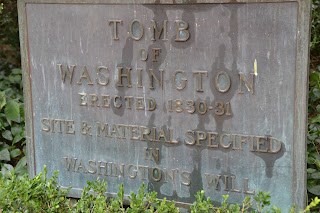The view from the porch. You can see Maryland across the river.
We went in the house for a tour and learned a lot about the Washingtons, life at the plantation, and Mount Vernon is general. Did you know George Washington was 6' 3" and his wife, Martha, was 4' 11"?! Mount Vernon has 9 guest bedrooms and two parlors. We also saw the Washingtons' bedroom which has the bed George Washington died in.
You can not take pictures in the house but this replica allows you to see a little bit of the house.
The kitchen
Smokehouse
Washhouse
"In 1781 the old wooden stables burned down. George Washington designed these new brick stables to replace it the following year. Many of George Washington's horses were kept here including Magnolia, an Arabian race-horse, and Nelson and Blueskin, the horses he rode during the Revolutionary War. Peter Hardiman oversaw the care of the horses and George Washington broke all of his horses himself." Up to 20 horses could be stalled at one time.
"The Washington's had two carriage drivers, Joe and Jack."
"The gardener's house was built in 1775. In 1799 the gardener was a Scotsman named William Spence."
"The salt house held large quantities of salt, which was used primarily for preserving fresh meat, fish and vegetables. The salt came from Liverpool, Lisbon, Portugal, and the Caribbean."
"George Washington practiced selective breeding of sheep to produce better quality wool, grain flax for making linen cloth, cultivated hemp for rope, and experimented with cotton and silk."
"Each of Washington's five farms had its own overseer who managed free and enslaved labor, supervised livestock and crops, and submitted weekly work report. In 1799 the overseer was Roger Farrell."
Blacksmith shop
Slave's quarters: men's bunk room
Slave's quarters: women's bunk room
"The stove room provided heat that palms, orange trees, lemon trees, and other tropical plants in George Washington's greenhouse needed to survive Virginia winters."
"Mount Vernon's shoemakers were kept busy making shoes and repairing shoes for nearly 100 adult slaves who worked at the Washington's farms. All of them received one new pair of shoes each fall. In 1799, the enslaved shoemaker was William "Billy" Lee, the personal attendant who accompanied Washington during the Revolutionary War. He also fixed the Washingtons' saddles."
Many of George Washington's relatives are buried at Mount Vernon including his adopted daughter, niece, grand niece, nephew, and many other family members.
George Washington is also buried at Mount Vernon beside Martha in a spot he designated in his will. Some wanted to move his body to Arlington Cemetery but the family refused since he wanted to be buried at his home. George Washington's tomb is on the right and Martha's is on the left. The black door at the back is where about 25 other family members are buried.
This flag is like the one Washington had carried in the Revolutionary War
The path to the orchard and the orchard
"George Washington often attended this experimental garden with his own hands. Unfamiliar or exotic plants would be tested here. He observed the first spouting, recorded the cuttings which took hold, and noted the plants that might thrive when transplanted in his fields or groves."
Mrs. Washington was also fond of gardens. These were her flower gardens.
George Washington February 22, 1732 - December 14, 1799
"The love of my country will be the ruling influence of my conduct."
"Liberty, when it begins to take root, is a plant of rapid growth."
"The Constitution is the guide, which I will never abandon."
"Knowledge is in every country the surest basis of public happiness."
"Peace with all the world is my sincere wish."
posted by Sarah
























































